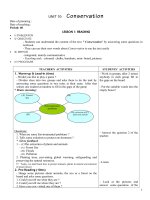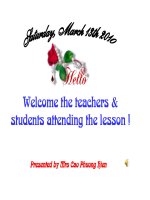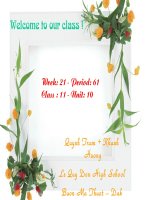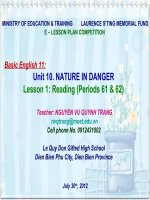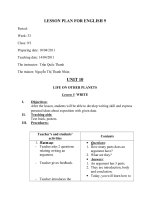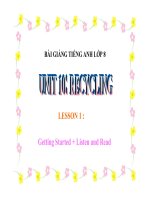GA tieng anh 10CB - Unit 10
Bạn đang xem bản rút gọn của tài liệu. Xem và tải ngay bản đầy đủ của tài liệu tại đây (289.25 KB, 12 trang )
Unit 10: Conservation
Date of preraring :
Date of teaching :
Period: 60
lesson 1: reading
• I/ Stabilization
• II/ objectives
- Students can understand the content of the text " Conservation" by answering some questions in
textbook.
- They can use their new words about Conservation to say the text easily
• III/ method
- integrated, mainly communicative
- Teaching aids: coloured chalks, handouts, mini- board, pictures.
• IV/ procedure
Teacher's activities Students' activities
1. Warm-up & Lead-in (6ms)
- Would you like to play a game ?
- Divides class into two groups and asks them to do the task by
answering some questions in two mins at their seats. After that
selects one student at random to fill in the gaps of the game
* Brain storming:
Questions:
1. What are some Environmental problems ?
2. Tells some solutions to protect environment ?
* Gives feedback
1. - (C)The extinction of plants and animals
- (A) Forest fire
- (B) Floods
- (D) Pollution
2. Planting trees, preventing global warming, safeguarding and
preserving the natural resources.
☞ Today, we shall learn how to protect animals, plants in natural environment
(Conservation)
2. Pre-Reading (10ms)
- Hangs some pictures about animals, the zoo or a forest on the
board and asks some questions.
1. Could you tell me what they are ?
2. Could you tell me where they are ?
3. Have you ever visited one of them ?
- Work in groups, after 2 minus
anybody in each group fill in
the gaps on the board
- Put the suitable words into the
empty boxes!
- Answer the question 2 of the
teacher.
- Listen
- Look at the pictures and
answer some questions of the
1
The extinction of (C)
plants and animals
(A) Forest
fire
(D)
(B)
Environmental
problems
4. What animals are you interested in ?
5. Should we protect animals and forests ?
* Gives feedback
1. They are an elephant, a monkey.
2. They are in the forest or in the zoo.
3. Yes.
4. ........Either monkey or elephant......
5. Yes, we do
* Task 1
- Asks Ss to read in silence the text and underline the strange
words
* Teaches Vocabulary
- loss of forest : Sự mất rừng
- destroy (v)
- destruction (n)
- constant supply (of water) : Sự cung cấp nớc thờng xuyên
- Hydroelectric dam: Đập ngăn nớc
- circulation (n): sự thông thoáng nớc
- run-off : chảy trôi đi
- valuable soil: đất quí giá
- Rapid run-off : sự thoát nớc nhanh
- damage(n): sự thiệt hại
(v): làm hại, gây tổn hại
- clean up: xoá sạch
- worsen(v): làm trở nên tồi tệ hơn
- nature's defence: bảo vệ thiên nhiên
* Trains the speech for Ss
* Task 2
- Gives handouts and asks Ss to fill in the gaps (word-form). They
work in group
- Goes around to help Ss
Noun Verb Noun Adjective
1. protect A. damage
2. destroy
B. environment
3. pollution C. sick
4. damage D. industry
5. conservation E. valuable
6. disappearance
disappear F. natural
* Gives feedback
1. protection A. damaging
2. destruction B. environmental
3. pollute C. sickness
4. damage D. industrial
5. conserve E. value
F. nature
* Trains the speech for Ss
teacher. (individuals)
- Work in pairs before class
- Read in silence the text and
underline the strange words
- Take notes
- Train the speech chorus and
individuals
- Work in pairs to fill in the
gaps
- Complete task 2 on the board
(2 groups)
- Train the speech chorus and
individuals
3. While-Reading (14ms)
* Task 3
- Asks Ss to scan the text and take out some phrases relating new
words in column A (Task 1 page 105)
* Goes around to help Ss
* Gives feedback: 1. C 2.A 3. D 4. B
* Task 4
- Work individuals and then
compare with their friends'
results
- Practise in pairs to learn by
heart some definitions
- Read in silence and find
information in the text to decide
2
- Asks Ss to read the text in silence and decide whether the
following statements are true (T) or false(F) (Task 2 page 106)
* Gives feedback: 1. F 2.T 3. T 4. T 5. F 6. F
* Task 5
- Asks Ss to work in group to find the topic sentence for each
paragraph
- Where is the topic sentence often put in each paragraph ?
- Where is the main idea for each paragraph often put ?
- What are topic sentences for three paragraphs
* Gives feedback:
- Par. A: many of those plants and animals could be used as
medicines against cancer, AIDS, heart disease and many other
sicknesses
- Par. B: Man and most animals need a constant supply of water to
live.
- Par. C: The earth is being threatened and the future looks bad.
What can each of us do ?
* Task 6
- Asks Ss to choose the most suitable main idea for each paragraph
(Task 3 page 106)
* Gives feedback:
- Par. A: Forests give us a lot of valuable things
- Par. B: We cannot live without water
- Par. C: Let's do something to save the earth
whether they are T or F
- Work in groups and answer
the question
- The topic sentence is often put
at the beginning , in the middle
or at the end for each paragraph
- It is often put in the topic
sentence.
- Work in groups to do the task
3 page 106
4. Post-Reading (10ms)
* Task 7
- Asks Ss to ask & answer some questions in textbook (page 106)
- Goes around to help Ss complete their exercises
* Gives feedback:
1. The loss of much forests is destroying the earth.
2. Man and most animals need a constant supply of water to live.
Farmers need water for their crops.
3. We should stop polluting rivers and seas and stop the
disappearance of plants and animals.
* Task 8
- Base on some questions above to say again Conservation
- Goes around to help Ss complete their exercises
* Gives feedback:
- Work in pairs and then
practise before class
- Work in groups
- Present their results
5. Consolidation & Homework (5ms)
- Summarizes the lesson
- Write a paragraph about ( 50 words ) what we should do to conserve our natural
environment , using some clues
+ We should: recycle paper, bottles and clothes, protect tropical rainforests, plant more
trees, save water and energy
+ We shouldn't : throw away paper, bottles and clothes, destroy tropical rainforests, cut
down trees, waste water and energy
- Asks Ss to prepare Speaking
Unit 10: Conservation
3
Date of preraring :
Date of teaching :
Period: 61
lesson 2: speaking
• I/ Stabilization
• II/ objectives
- Students are able to present the safeguarding of the wildlife such as building wildlife preserves
- Ss are able to ask and answer some questions about conservation naturally
• III/ method
- integrated, mainly communicative
- Teaching aids: coloured chalks, handouts, mini- board, pictures
IV/ procedurE
Teacher's activities Students' activities
1. Lead-in (6ms)
* Gives handouts and ask Ss to classify animals the following
categories
* Gives feedback
(1) horse, sheep, pig, hen, fish
(2) cat, dog, fish, cat
(3) elephant, monkey, tiger, snake, lion, tortoise, panda
Questions:
1. Have you been to the zoo?
2. Have you ever seen all of these animals?
3. What animals are in danger?
2. Pre-Speaking (10ms)
• Task 1
- Asks Ss to read the passage A and B in textbooks and
answer questions.
- Goes around to help Ss
- Explains some difficult words
+ Sensitive (adj) + breed (n)
+ be imprisoned + gorilla (n)
+ Will (n) + reconstruct(v)
- Gets Ss to repeat the vocab.
* Gives feedback
1. It is used to provide as natural an environment as natural as
possible for the animals
- Work in group, write answers
down the paperboards, after 2
minus groups hang their
answers on the board.
- Answer three questions
- Read passages and answer
questions.(Work in pairs)
- Repeat
- Work in pairs before class
4
horse, elephant, monkey, sheep, pig, hen, tiger, snake, cat,
fish, lion, tortoise, panda, dog
animals
(1)
Farm
animal
s
...........
(2)
Pets
..........
(3)
Wild &
zoo
animals
............
.....
2. - the place where endangered species can develop
- animals can live in natural environment
- they are not the place where animals are imprisoned
• Task 2
- Gets Ss to read the requirements in Task 2 for agreeing or dis
agreeing
* Gives feedback : yes, no, yes, yes, yes
3. While-Speaking (14ms)
• Task 3
- Gets Ss to work in groups to discuss the advantages and
disadvantages of zoos of the new kind
Advantages Disadvantages
- the conditions the animals
are in
- the animals that people can
visit
- animals can do what they
want to
- animals may feel happier
and better
- the money spent on
reconstructions of the
animals natural
environment
- the dangers that the
keepers may have
- Asks Ss to give more advantages and disadvantages of zoos
of the new kind by making conversation
P
1:
I think
zoos of the new kind are very good for animals
P
2
: I am able to agree with you more. But it is very
expensive to reconstruct animals natural environment
P
1:
I suppose you are right. However, animals in the zoos of
the new kind can live better.
P
2
:
Perhaps you are right.
4. Post- Speaking (10ms)
• Task 4
- Gets Ss to work in groups to report the views of advantages
and disadvantages of zoos of the new kind
- Gives praise for the best report
- Read the requirements in
Task 2 for agreeing or dis
agreeing
- Work in groups to discuss
the advantages and
disadvantages of zoos of the
new kind, using the suggestions
- Work in pairs to say more
advantages and disadvantages
of zoos of the new kind
- Work in groups to discuss
the advantages and
disadvantages of zoos of the
new kind.
- After 6mins, call somebody
at random to report their group's
views
5. Consolidation & Homework (5ms)
- Summarizes the lesson
- Suggests that Ss should write a short paragraph about building wildlife preserves
- Asks Ss to prepare Listening.
Unit 10: Conservation
5
